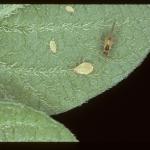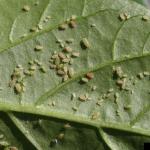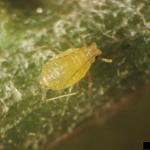Aphid, Green Peach
Myzus persicae persicae
Identification:
Winged green peach aphids have a black head and thorax and yellow-green abdomen. Wingless adults and nymphs are usually pale yellow green including the cornicles (a pair of tubes near the tip of the abdomen) but may be pink. Adults reach 2 mm long. Aphids feed on leaves and excrete a sugary, sticky substance called “honeydew” which coats fruit and fosters growth of black sooty mold fungus.
Life Cycle:
Green peach aphid overwinters in the egg stage on woody plants in the Prunus species, where nymphs feed in spring. Field vegetable crops are colonized in June by winged females who produce live young (nymphs), resulting in multiple generations of wingless females. Generation time from birth to reproductive adult is one to two weeks depending on temperature; each female produces 30-80 live young. If food quality declines, winged females develop and leave in search of new plants. In fall, both male and female winged aphids develop and return to woody plants to mate and lay eggs.
Crop Damage:
The major damage caused by this aphid is the transmission of many different plant viruses; aphids are the most important vector of viruses in vegetable crops, and green peach aphid is a universal vector. It is also a pest in greenhouses.
Besides spreading virus diseases, aphids in high numbers can cause economic damage by their feeding activities. Leaf curling and yellowing or deposits of honeydew on leaves or fruit can affect crop quality or yield. For this reason it is important to manage aphids even if viruses are not a concern.
Numerous crop families (including solanacous crops, cucurbits, brassicas, spinach and chard, and carrot families) as well as broadleaf weeds support green peach aphid.
Monitoring & Thresholds:
Begin to examine plants in early July for aphids and the presence of beneficial species. Scouting across a field gives you an estimate of current numbers. If aphids are present, check back in a few days to see if the numbers are increasing or decreasing. Take note of which natural enemies are present. Check undersides of leaves, including lower and mid level leaves. Spray only when aphids are increasing and building up to high numbers. Treatment thresholds vary between crops - see below for specific thresholds. Treat at 5-7 day intervals. For more detailed information about scouting for aphids in specific crops, please see the Insect Management section of each of the following crops on the New England Vegetable Management Guide website - each crop name is linked to the appropriate page.
- Pepper: >10 aphids/leaf before fruit set, and 5/leaf after fruit set (based on 4 leaves/plant, 25 plants)
- Tomato: >6 aphids/leaf (based on 3 leaves/plant, 25 plants)
- Spinach: 1 aphid/seedling, or 4-10 aphids/plant on older plants
- Pumpkin, Squash, Gourds: >4 aphids/leaf on 20% of leaves (based on 50 leaves)
- Potato:
-
Fresh market & processing potato (based on 25-50 compound leaves)
-
Before tuber initiation: 2 aphids/leaf
-
Tuber initiation through 2 weeks before vine kill: 4 aphids/leaf
-
Within 2 weeks of vine kill: 10 aphids/leaf
-
-
Maine seed potatoes: 50% plants with aphids, or 1 winged green peach aphid found in the field
-
- Eggplant: 1-2 aphids/leaf
- Cucumber, Muskmelon, & Watermelon: aphids on >20% of runners
- Sweet corn: Pre-tassel - 50% plants infested, or 25% heavily infested (based on 100 plants)
- Beans: >4 aphids on 50% of terminal shoots
Cultural Controls:
- Plant crops away from Prunus spp. (peach, wild cherry, etc.).
- Reduce areas of bare soil around or within the crop. Aphids find plant tissue based on the color contrast between the foliage and the bare ground, so if there is no bare ground the aphid cannot “see” the crop. Reflective plastic mulch repels aphids as long as 50% of the surface area is reflective. Even black plastic mulch has been shown to reduce aphid numbers compared with bareground culture.
Chemical Controls:
When spraying, coverage of underleaf surface is important. Add a spreader-sticker. Spray effectiveness may vary depending upon the aphid species present. Use selective products to conserve beneficials that suppress aphids. In fruiting crops (solanaceous crops, cucurbits, and beans), avoid using products that are toxic to bees during bloom, or treat in the evening after bees stop foraging.
Systemic materials are generally the most effective insecticides available for aphid control, however if you are controling aphids as a means to control viruses in your crop, systemic materials are often ineffective and can even amplify virus problems in crops. Systemic insecticides are taken into the plant and become present in the plant juices. Aphids feed by sucking juices from the plant, and when they do so they also ingest some of the insecticide. However, when just probing a leaf an aphid is not feeding and does not ingest plant juices or insecticide. In fact, the presence of an insecticide may actually stimulate probing and cause aphids to move from plant to plant in an effort to fine a suitable feeding site. This can increase the spread of nonpersistent viruses. For virus control, aphid repellants such as horticultural oils (especially early on when aphid populations are low and plants are young) and newer behavior modifying pesticides may be of use, including Assail, Belay, Admire Pro, Fulfill, Movento, and Platinum.
Biological Controls:
Aphids are usually controlled on peppers by natural predators and parasites, such as lady beetles, lacewings, spiders, syrphid fly larvae, wasps, and beneficial fungi, unless the populations of these beneficials are disrupted by chemical sprays. Preserve natural enemies by using selective/microbial pesticides for other pests whenever possible. Occasionally green peach aphid (GPA) or, less commonly, melon aphid (MA) and potato aphid (PA) populations build up and require controls. Early-season, broad-spectrum sprays will destroy beneficials and lead to aphid population buildup.
In general, aphid predators are better at controlling high aphid populations, compared to parasitoids, as they are not as efficient at finding low numbers of aphids within the crop.
Ladybeetles are effective at controlling high aphid populations but are highly dispersive and will leave the tunnel in search of food if aphid populations are too low. They can be effective if released under row cover in winter greens. Adults and larvae feed on a wide variety of aphid species.
Predatory midges (Aphidoletes aphidimyza) are another generalist aphid predator that can be purchased and released in your tunnel. They are active in summer months but when day lengths shortens to less than 15 hours (September-March), they enter diapause and become inactive. Larvae feed on aphids and adults feed on pollen and aphid honeydew. Banker plants used to support Aphidius colemani will also support Aphidoletes midges. The midges pupate in the soil, so place banker plants in a tray with moist sand to provide pupation sites if your tunnel has plastic mulch and weed mat.
Green lacewing larvae also feed on many aphid species. Adults feed on pollen and nectar. Lacewings can be purchased as eggs or larvae; larvae tend to survive better than eggs. Release far apart from each other, as larvae are cannibalistic. In summer months, if temperatures rise above 95°F, lacewings will move out of the tunnel. Lacewing activity and life cycle slows as temperature drops, but one report from Purdue University reported that adults remained active and laying eggs at 52°F.
For current information on production methods (including varieties, spacing, seeding, and fertility), weed, disease, and insect management, please visit the New England Vegetable Management Guide website.
Crops that are affected by this insect:
- Basil
- Beans, Snap, Dry, and Lima
- Beets and Swiss Chard
- Celery
- Cucumber, Muskmelon, and Watermelon
- Eggplant
- Okra
- Pepper
- Potato
- Pumpkin, Squash, and Gourds
- Rutabaga and Turnip
- Sweet Potato
- Tomato, Field
- Tomato, Greenhouse
--From the New England Vegetable Management Guide "Pepper, Insect Control" and "PVY: What Can You Do?" by Sue Scheufele, 2016
The Center for Agriculture, Food and the Environment and UMass Extension are equal opportunity providers and employers, United States Department of Agriculture cooperating. Contact your local Extension office for information on disability accommodations. Contact the State Center Director’s Office if you have concerns related to discrimination, 413-545-4800 or see ag.umass.edu/civil-rights-information.


